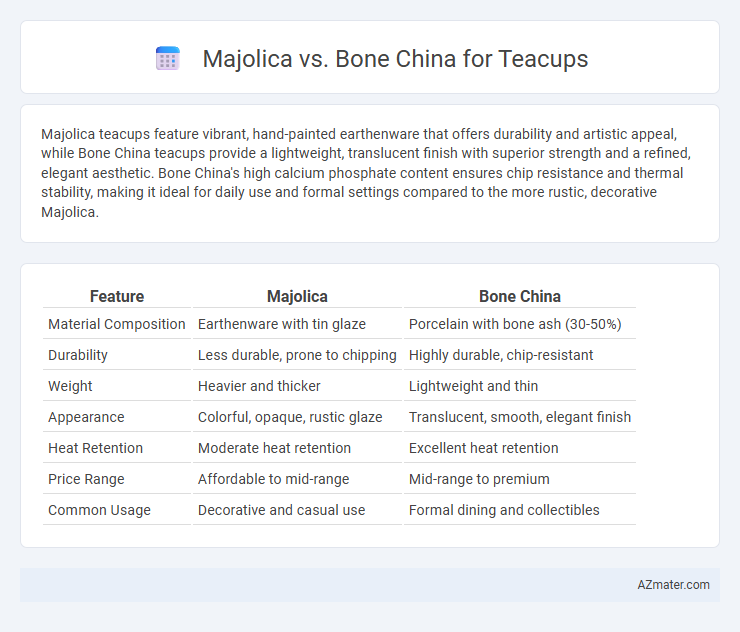Majolica teacups feature vibrant, hand-painted earthenware that offers durability and artistic appeal, while Bone China teacups provide a lightweight, translucent finish with superior strength and a refined, elegant aesthetic. Bone China's high calcium phosphate content ensures chip resistance and thermal stability, making it ideal for daily use and formal settings compared to the more rustic, decorative Majolica.
Table of Comparison
| Feature | Majolica | Bone China |
|---|---|---|
| Material Composition | Earthenware with tin glaze | Porcelain with bone ash (30-50%) |
| Durability | Less durable, prone to chipping | Highly durable, chip-resistant |
| Weight | Heavier and thicker | Lightweight and thin |
| Appearance | Colorful, opaque, rustic glaze | Translucent, smooth, elegant finish |
| Heat Retention | Moderate heat retention | Excellent heat retention |
| Price Range | Affordable to mid-range | Mid-range to premium |
| Common Usage | Decorative and casual use | Formal dining and collectibles |
Introduction to Majolica and Bone China
Majolica is a vibrant, earthenware pottery known for its colorful, tin-glazed surface that creates a glossy, decorative finish, prized for artistic teacups. Bone China, crafted from bone ash, kaolin, and feldspar, offers exceptional strength, translucency, and a delicate, white appearance ideal for fine teacups. Both materials possess unique aesthetic qualities and durability, influencing preferences among collectors and everyday users.
Historical Background of Majolica
Majolica pottery, originating in the Renaissance period of 15th-century Italy, is known for its vibrant tin-glazed earthenware that showcases intricate, colorful designs inspired by Mediterranean art. This ceramic technique spread across Europe, influencing decorative approaches with its opaque white glaze and bold hand-painted motifs. Unlike the refined, translucent nature of bone china developed in 18th-century England using bone ash, Majolica reflects a historical emphasis on ornamental and rustic aesthetics in teacups.
Origins and Evolution of Bone China
Bone china, originating in 18th-century England, revolutionized fine teacup craftsmanship by incorporating bone ash into porcelain, enhancing translucency and strength. Its evolution stemmed from innovators like Josiah Spode, who perfected the recipe to create a durable yet delicate material favored globally. In contrast, majolica is a tin-glazed pottery with Renaissance roots in Italy, distinguished by vibrant, colorful designs but lacking the refined translucency characteristic of bone china.
Material Composition: Majolica vs Bone China
Majolica teacups are crafted from earthenware clay glazed with vibrant, lead-based finishes, offering a dense, rustic texture, while bone china teacups consist primarily of bone ash (around 25-50%), kaolin, and feldspar, resulting in a lightweight yet durable porcelain with high translucency. The calcium phosphate in bone ash enhances bone china's strength and chip resistance, setting it apart from the more porous and heavier majolica. Majolica's opaque and heavier composition contrasts with the thin, semi-translucent quality of bone china, making each material distinct in both tactile feel and aesthetic appeal.
Aesthetic Features and Design Differences
Majolica teacups showcase vibrant, hand-painted glazes with intricate floral and nature-inspired motifs, highlighting a rustic and artistic charm. Bone china teacups are prized for their translucent, delicate appearance, smooth surface, and elegant, often minimalist designs emphasizing fine craftsmanship. The contrast lies in Majolica's colorful, textured finish versus bone china's refined, polished look that complements formal settings.
Durability and Everyday Use
Majolica teacups are known for their vibrant, glazed ceramics that offer good durability and resistance to chipping, making them suitable for everyday use in casual settings. Bone china teacups provide exceptional strength despite their delicate appearance, featuring a high level of translucency and resistance to thermal shock, which makes them ideal for daily use with elegant presentation. While bone china balances fragility and toughness effectively, majolica excels in sturdiness with a more rustic, artistic appeal for frequent handling.
Heat Retention and Functional Qualities
Majolica teacups, crafted from glazed earthenware, offer moderate heat retention due to their porous nature and thicker walls, making them ideal for retaining warmth briefly while providing a vibrant, decorative finish. Bone China, composed of bone ash, feldspar, and kaolin clay, boasts superior heat retention and exceptional durability, thanks to its fine, dense structure that insulates heat effectively and resists chipping. Functional qualities such as lightweight design and translucency in Bone China enhance the drinking experience by keeping tea warmer longer and offering a refined aesthetic compared to the heavier, more rustic feel of Majolica.
Care, Maintenance, and Cleaning Tips
Majolica teacups, known for their vibrant glazes and porous surface, require gentle handwashing with mild soap and soft sponges to prevent glaze damage and avoid dishwasher use. Bone china teacups, prized for their delicate translucency and durability, can withstand dishwasher cleaning but benefit from handwashing to maintain their lustrous finish and prevent fine cracks over time. Both materials should be stored carefully to avoid chipping, with bone china needing extra caution due to its finer composition.
Price Comparison and Collectibility
Majolica teacups, known for their vibrant colors and intricate glaze patterns, are generally more affordable than bone china, which commands higher prices due to its fine translucency and durability. Collectors prize bone china for its elegance and long-standing reputation in luxury tableware, often leading to higher resale values and demand. Majolica, while less expensive, attracts collectors interested in artisanal craftsmanship and historical styles, making both materials appealing but differently valued in the market.
Choosing the Right Teacup: Which is Best for You?
Majolica teacups offer vibrant, hand-painted designs with a robust, rustic feel ideal for casual or artistic settings, while Bone China teacups provide lightweight, translucent elegance and superior durability suited for formal occasions. Choosing between Majolica and Bone China depends on your preference for aesthetic style and everyday usability versus delicate sophistication and refined presentation. Consider the teacup's intended use, maintenance ease, and your personal comfort with ceramic thickness and weight when selecting the perfect teacup.

Infographic: Majolica vs Bone China for Teacup
 azmater.com
azmater.com